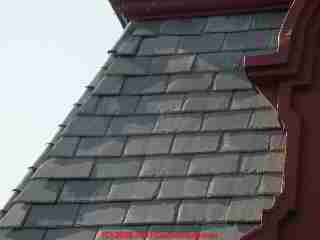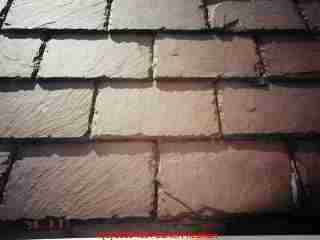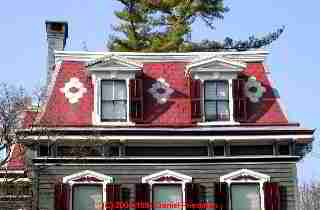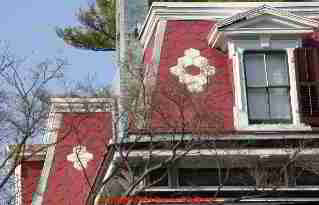 The Colors & Chemistry of Roofing Slates
The Colors & Chemistry of Roofing Slates
- POST a QUESTION or COMMENT about different colors of roofing slate
Roofing slate colors & chemistry:
How does the composition of roofing slates affect their life? A quick guide. Because the properties, including durability, of roofing slates vary widely, and because the properties of roofing slates depend largely on the quarry from which the slate originated, it is worth knowing what you can probably expect from a roofing slate by its appearance and color.
Appearance and color are not substitutes for a chemical analysis of the slate, but they can often tell us quickly about the slate's probable source and about how long it is likely to last. This series of detailed slate roof inspection and repair articles describes procedures for evaluating the condition of slate roofing.
InspectAPedia tolerates no conflicts of interest. We have no relationship with advertisers, products, or services discussed at this website.
Slate Colors, Chemistry, Durability
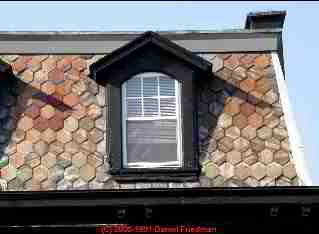
According to the National Slate Association slate is a stone material which has an indefinite life.
How to inspect, identify defects, and estimate remaining life of slate roofs are addressed. The article series also references slate repair procedures, repair slate sources, and slate quarries. We also provide slate sources and where to buy slate roofing materials and slate roofing tools and products.
[Click to enlarge any image]
Slate Roofs, reprinted by the Vermont Structural Slate Co. We caution readers that while this is absolutely the best reference we've found on slate roofing, the language on durability is a bit enthusiastic. You'll have to look closely at the footnotes to identify the less durable materials.
Because the actual composition of slate affects its durability (and cost), the identification of the source of existing slates is useful in evaluating the condition and future life of a roof.
Common sources of roofing slates used in the US and Canada are Pennsylvania, Virginia, and Vermont. California, Georgia, Michigan, New York and Maine also have or had slate quarries.
In 1924 the remaining active slate quarrying areas were Maine, Vermont-New York, Pennsylvania, and Virginia. Common slate names have British origins. Maine's Bangor slate looks a lot like Bangor blue mined in North Wales.
Identification of the slate source by visual inspection is difficult by other than experienced slate handlers or laboratories. However as the slate source has such a dramatic effect on the expected life of the material, any anecdotal, historical, or visual clues are useful. Readers are cautioned not to assume that slates in their area necessarily came only from the nearest slate quarry.
Though that's a reasonable bet in many cases, one might find Virginia slate or Maine slate on roofs as distant from the quarries as British Columbia! Vermont Structural Slate Co. will identify slates if you mail them a 1.5"x1.5" triangular sample.
Basic slate roofing colors, their composition, and their sources
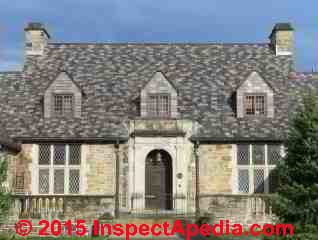 Basic roofing slate colors are black, blue-black, gray, blue-gray, purple,
mottled purple and green, green, and red. These color names should be preceded by designations of "unfading" or "weathering" (discussed
later). Color is determined by variations in chemical and mineral composition.
Basic roofing slate colors are black, blue-black, gray, blue-gray, purple,
mottled purple and green, green, and red. These color names should be preceded by designations of "unfading" or "weathering" (discussed
later). Color is determined by variations in chemical and mineral composition.
The mineral composition of the shale from which slates are cut varies significantly among quarries and from state to state in the US. The primary constituents are white and black mica.
See later details in this article. A detailed procedure for analysis of slates was documented in US Geological Survey Bulletin #700, "The Analysis of Silicate and Carbonate Rocks", by Dr. W.F. Hillebrand.
At left: a recently installed (ca 2013) slate roof on the Vassar College Campus in Poughkeepsie, New York.
Virginia roofing slate colors & characteristics
Virginia Roofing Slate is blue-gray in color, tough, durable, and considered a top quality material by most slate sources. This slate is notable for a peculiar luster giving attractive lights and shadows on roofs.
Vermont roofing slate colors & characteristics
Vermont roofing slate is typically green with purple, black, and red available. Vermont green slate is the most abundant, with well developed cleavage (easy to split into roofing slates), with good "fissibility" (relatively easy to work), making it the most common variety used.
Slate from Vermont is lower in lime content than the Pennsylvania variety. Chemical composition of slates varies of course by quarry as does slate color. Slates are available in both fading and non-fading varieties. In Vermont slate fading color is not considered an indication of deterioration. Rather it's an aesthetic factor.
Blue-gray Pennsylvania roofing slate colors & characteristics
Pennsylvania blue-gray slate is possibly the best known and most widely distributed of the common slate colors. Some architects and roofers call these slates Pennsylvania black.
But as "Black-Bed" slates, a less durable material, might be confused with the better quality Pennsylvania material, the blue-gray name should be used.
Unfading Pennsylvania gray roofing slate color, appearance, characteristics
This is probably a Pennsylvania Gray slate roof on a NY College Campus in Poughkeepsie. Unfading Pennsylvania gray slate, which weathers or fades less than "weathering" varieties, has soft gray tones and may have additional strength or durability.
Unfading Pennsylvania black, heavier than other slates, has a rougher appearance and does not, as its name claims, fade significantly. [Fading may be taken to mean a general "lightening" across the slate.] Blue-black "hard-vein" Pennsylvania slates are hard material which grows darker on exposure to weather.
Gray and Grey-Black roofing slates, where they are from, and their characteristics
Gray and gray-black roofing slates are quarried in Vermont and parts of New York. The gray is lighter than the Pennsylvania blue-gray.
You may find it mixed with purple. Gray-black is quarried in both light and dark grays, some with a mottled effect.
Unfading green, weathering green, unfading purple, unfading mottled purple and green, variegated purple have been quarried in Vermont and New York.
Unfading red roofing slate, where it is quarried, and its wear characteristics
Unfading red roofing slate is quarried only in Washington County, New York.
Classic real slates remain on this red slate roof in New York's Hudson Valley. Perhaps slates from the Granville NY quarry - we don't know how long this superb material will last as we've never found one that was worn out on a roof.

A nice red slate roof with white details in Poughkeepsie, NY.
More of this nice-condition red "slate" roof in Poughkeepsie, NY. From the ground this roof looks too uniform - we wonder if it's a synthetic slate look alike?
Closer
inspection is needed.
Ribbon Slates vs "Cleare Slates"
We did not find references listing sources of ribbon slate other than Pennsylvania's Lehigh-Northampton district quarries. Ribbon slate is identified by diagonal "stripes" visible in the shingles.
We show more examples of ribbon slates
at RIBBON SLATE
and we discuss ribbon slates in tiresome (for some but not for me) detail
at SLATE ROOF TYPES, RIBBON SLATE.
We provide other comments about slates with diagonal mineral inclusions besides ribbons also discussed
at SLATE ROOF LIFE EXPECTANCY.
Slates which contain no ribbons are referred to as "clear" slates.
Freak slate colors, what are "freak roofing slates"?
If you find slate which is not one of these colors it's a "freak". It would be rare to find a freak which was quarried thinner than 1/4", usually in greater thickness up to 2".
Some "freak roofing slates" are not true slates in every quality and may not be salvageable when worn or on roofs in poor condition.
About The Authors
Alan Carson and Daniel Friedman are [or were] ASHI Members, home inspectors, educators and writers in Toronto and Poughkeepsie respectively. Information in this article is taken from the references shown below, from inspection experience, from opinions shared at ASHI and other education seminars, from the authors' personal, limited experience repairing and rebuilding of slate roofs, and from very helpful Bill Markcrow and Doug Sheldon at Vermont Structural Slate Co.
We also paraphrased from a presentation to NY Metro ASHI Members by Mr. Steven Trapasso in October, 1990. Mr. Trapasso has 40 years experience in working with slate, and has a clear love affair with the material, particularly when it comes from Vermont.
...
Continue reading at MANUFACTURED / SYNTHETIC SLATE ASBESTOS CONTENT or select a topic from the closely-related articles below, or see the complete ARTICLE INDEX.
Or see these
Recommended Articles
Suggested citation for this web page
SLATE ROOF COLORS & SLATE CHEMISTRY at InspectApedia.com - online encyclopedia of building & environmental inspection, testing, diagnosis, repair, & problem prevention advice.
Or see this
INDEX to RELATED ARTICLES: ARTICLE INDEX to BUILDING ROOFING
Or use the SEARCH BOX found below to Ask a Question or Search InspectApedia
Ask a Question or Search InspectApedia
Try the search box just below, or if you prefer, post a question or comment in the Comments box below and we will respond promptly.
Search the InspectApedia website
Note: appearance of your Comment below may be delayed: if your comment contains an image, photograph, web link, or text that looks to the software as if it might be a web link, your posting will appear after it has been approved by a moderator. Apologies for the delay.
Only one image can be added per comment but you can post as many comments, and therefore images, as you like.
You will not receive a notification when a response to your question has been posted.
Please bookmark this page to make it easy for you to check back for our response.
Our Comment Box is provided by Countable Web Productions countable.ca
Citations & References
In addition to any citations in the article above, a full list is available on request.
- In addition to citations & references found in this article, see the research citations given at the end of the related articles found at our suggested
CONTINUE READING or RECOMMENDED ARTICLES.
- Carson, Dunlop & Associates Ltd., 120 Carlton Street Suite 407, Toronto ON M5A 4K2. Tel: (416) 964-9415 1-800-268-7070 Email: info@carsondunlop.com. Alan Carson is a past president of ASHI, the American Society of Home Inspectors.
Thanks to Alan Carson and Bob Dunlop, for permission for InspectAPedia to use text excerpts from The HOME REFERENCE BOOK - the Encyclopedia of Homes and to use illustrations from The ILLUSTRATED HOME .
Carson Dunlop Associates provides extensive home inspection education and report writing material. In gratitude we provide links to tsome Carson Dunlop Associates products and services.


